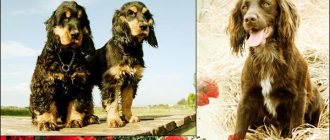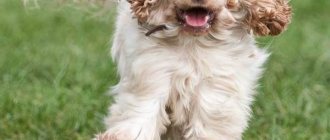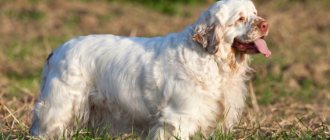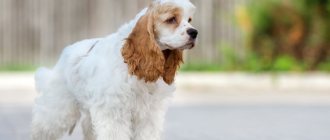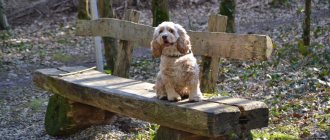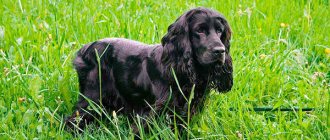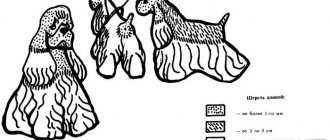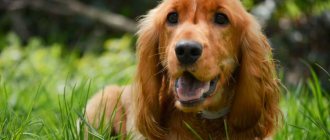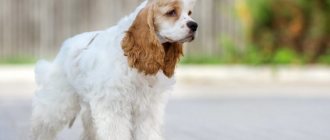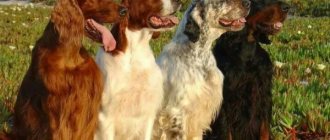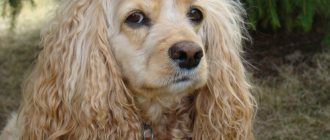| Origin: | England |
| Usage: | companion, bird hunting |
| Color: | any |
| Dimensions: | 38 – 39 cm females, 39 – 41 cm males, weight – 12.5 – 14.5 kg |
| Lifespan: | 12 – 14 years old |
The restless and cheerful English Cocker Spaniel is a perpetual motion machine in the world of dogs. This is a kind and energetic dog who never loses heart. Initially, the breed was used for hunting game. But today it is more often found as a companion, although the animals have not lost their instincts.
Breed characteristics
| Short description | |
| Origin: | Great Britain |
| Conditions of detention: | In an apartment, private house |
| Purpose: | Companion dog, herding dog, rescue dog, nurse dog |
| Color: | Various, popular among breeders Blenheim (distinct chestnut spots on a white background), also available in gold, black, white colors |
| Wool length: | Medium and long (limbs, groin, bottom of the last) |
| Adult dog size: | Height of females 38–39.5 cm, males 39–40.5 cm, weight of females 12-14 kg, weight of males 13-15 kg |
| Average life expectancy: | 13-16 years old |
| Walk: | 2-4 times a day |
| Physical activity needs: | Average physical activity needs (walking 1 to 1.5 hours per day) |
| Fédération Cynologique Internationale (FIC) classification: | Group 8: Retrievers, Paniels, Water Dogs; Section 2: spaniels, with performance tests |
| Puppy price: | 6,000–20,000 rubles |
Price
It is better to purchase a puppy from experienced breeders, where its price will be about 10 thousand rubles.
Of course, you can buy a four-legged animal from an unverified seller for three thousand rubles, but the likelihood of getting a purebred or even a sick baby will be extremely high.
If you need not just a faithful friend and family member, but a dog that can later be presented at exhibitions and used as an inseminator for breeding offspring, then the cost of such a dog will be from 15-30 thousand rubles and more.
History of the origin of the species
The origins of the English Cocker Spaniel date back to the Bronze Age. The ancestors are considered to be ancient hunting dogs called “ashy”. Historians and archaeologists have found the remains of dogs in the ash. Ancient people presented them as sacrifices to the gods.
Ash or ash dogs had all the qualities of a hunter; they had developed body muscles and long limbs.
Centuries-old attempts to consolidate the hunting skills characteristic of one species led to the appearance of spaniels. One version connects the name of the breed with Spain. It is believed that the ancestors of modern spaniels were Spanish hunting dogs.
The British have a separate version of the origin of the breed. The word "spaniel" is equated to the English word "span spaniel" , meaning "one who can jump high" . Dogs on the hunt suddenly jump out of the thick grass, catching their prey by surprise.
The word "cocker" is the name of the woodcock bird. English cocker spaniels were bred to hunt birds, including woodcock, which is native to the British Isles.
The popularity of breeding hunting breeds among dog breeders arose in the 19th century. Official recognition and registration by English dog handlers occurred in 1893. The breed was recognized by the world community of dog breeders 9 years later, in 1902. But only in 1974 an international standard was approved and the breed was recognized by the Federation of Cynologists.
Russian dog breeders became interested in the British in the 70s of the last century. Dogs were imported from European countries. Dogs have become regular participants at Russian exhibitions since the 80s.
Application
Initially, the breed was intended exclusively for hunting wild birds. However, today the British cocker is a companion and family friend. He gained popularity thanks to his soft, flexible character.
The dual use of pets led to their division into 2 classes - working and exhibition. Any breed has this classification, but in cockers it is very pronounced.
Working dogs are used for hunting. Decorative - for participation in exhibitions and as pets. The latter are larger and less fast.
Regardless of class, any English Cocker dog has a strong hunting instinct. They even do a stance on the plane, mistaking it for a flying bird.
Distinctive features
The main parameters characterizing the English Cocker Spaniel:
- The head is regular in shape, with a clear outline.
- The ears are drop-shaped, long, thin, located in line with the eyes.
- The eyes are large, round, and dark shades of brown. Light eye color (light brown) is allowed in dogs with chocolate-colored fur.
- The nose is black with large nostrils (for a good hunter's instincts).
- The bite is scissor-shaped, the incisors develop strictly vertically.
- The back is physically well developed.
- The forelimbs are straight and small in size.
- The hind limbs differ significantly from the front limbs in their developed muscular system. Large hips, designed for fast running, characterize the dog's purpose as a hunter.
- Tail with thick hair. In an excited and joyful state, the height of the tail does not reach the height of the back.
- The coat is of medium abundance, without curls. Long hair is present on the legs and along the perimeter of the lower body.
Possible colors according to standard
Correct haircut for English cockers
Many owners of such dogs try to achieve a show look from their pet by cutting the hair in the back area. But experts note that doing this is strictly not recommended. To achieve the required result, you need to comb the coat to remove excess undercoat hairs, then the rest of the coat will lie evenly and tightly.
If you cut the guard hair even once, it will never be able to lie down properly, and the show expert may well reduce marks for the pet’s incorrect conformation.
Spaniels begin to be cut very early; most breeders hand over the puppies to new owners with a new haircut. This makes further care and trimming much easier.
Photo of an adult dog
Photos of puppies
Features of character and behavior
The English Cocker Spaniel is a cheerful, playful, good-natured dog. They adapt well to a large family and get along well with single people. However, only one person will be considered the real master and obey unquestioningly. The nature of a getter, strong muscles, and a strong sense of smell of a dog of this breed will also appeal to lovers of hunting and an active lifestyle.
Advantages
The advantages of the English Cocker Spaniel are:
- Beauty . The stately and impressive Briton will not go unnoticed while walking around the park.
- Intelligence – the dog understands human language well, which makes it easy to train.
- Developed intelligence and hunting disposition allows the spaniel to independently make important decisions in the shortest possible time.
- Friendly attitude towards children . Active games in the fresh air attract the dog; the spaniel will happily chase and frolic with the children. Parental vigilance still does not hurt, especially if the child is under 7 years old.
Flaws
The disadvantages include negative points:
- Pets are strongly attached to their owner , sometimes allowing them to show feelings of ownership and jealousy.
- Stubbornness is a characteristic trait of the breed. A calm explanation of the rules and training from an early age will help the owner raise an obedient pet.
- Some individuals are prone to long barking. Observation and consultation with a veterinarian will help the breeder rule out mental abnormalities.
Care and maintenance
Due to its small size, the English Cocker Spaniel is a suitable option for city dwellers. Life in a metropolis, in high-rise buildings, does not bother the dog at all. Hunting habits manifest themselves during walks; the pet can hide in tall grass, quickly run through puddles and get dirty.
Care includes procedures:
- Daily paw hygiene .
- The ears require special attention . Periodically removing ear discharge with a swab will save the owner from unnecessary hassle.
- The eyes are wiped with special drops or fresh tea leaves.
- To clean teeth, use toothpaste and a dog brush.
An additional nuance: due to their length, the ears of an English Cocker Spaniel end up in a bowl of food, and the hair on the ears will get dirty. Breeders are recommended to purchase a special deep narrow bowl or tie up the pet’s ears during meals. If the dog is adapted to dry food, the problem is eliminated.
Nutrition
The English Cocker Spaniel is famous for its increased appetite . Indiscriminate eating and the ability to beg for a piece, thanks to a child's naive look, often leads to obesity in the pet.
- The puppy's initial diet consists of dairy products (cottage cheese, kefir). It is further expanded by introducing meat in the form of minced meat and vegetables. After a positive decision from the veterinarian at 6 months of age, a transfer to dry or natural food is allowed.
- If the owner chooses natural nutrition, it is necessary to create a menu that includes a balanced portion of proteins, fats and carbohydrates. The frequency of feeding an adult cocker does not differ from the standards and is 2 times a day.
It is prohibited to feed the pupil sweets, pickled, salty, and spicy foods.
- Meat products are supplied only after heat treatment . Several times a week, meat is replaced with offal (heart, lungs).
- Milk protein is used in the form of fermented products to improve intestinal motility.
- The vegetable component is varied; cockers love carrots, zucchini, pumpkin, and cucumber. Heat treatment is not necessary; just wash the vegetables thoroughly and cut into pieces. For better absorption, add sour cream or vegetable oil.
- Vitamin therapy is carried out in consultation with a veterinarian.
The dog is active, the drinking regime is constantly maintained.
Health
The breed is positioned as strong and in good health. They adapt well to harsh weather conditions. On average, dogs live about 15 years. Proper nutrition, frequent walks, vaccinations are the key to the health and longevity of a cocker.
Vaccinations
Dogs are vaccinated according to the vaccination schedule. It is important to vaccinate your puppy against dangerous diseases during the first year of life.
At 2 months they are vaccinated against:
- Parovirus enteritis;
- Chumki;
- Leptospirosis.
At 3 months they are vaccinated against rabies. All vaccinations given by a specialist are indicated in the pet’s veterinary passport.
Before the procedure, the breeder is recommended to:
- Deworm the puppy;
- Get examined by a veterinarian;
- Find out from a specialist about the possible consequences;
- Agree on the brand of vaccine.
After the procedure it is prohibited:
- Walk (2 weeks);
- Contact with other dogs;
- Bathe;
- Change your diet;
- Raise your voice at the dog, criticize.
Diseases
Despite the genetically inherent good health, acquired diseases, as well as those transmitted by inheritance, cannot be excluded.
Specific diseases of the English Cocker Spaniel:
- Mental disorders (aggression, panic, hysteria).
- Skin dysfunction. The breed is characterized by a disease - asthenia. It is characterized by a violation of the strength and elasticity of the skin, as a result of which wound surfaces appear on which fungal diseases begin to develop. Treatment of the disease is long-term, using antimycotic drugs.
- Dysfunction of the visual organs (cataracts, glaucoma, entropion).
- Weak joints . If hip dysplasia is not detected in time, it leads to complete immobilization.
- Diseases of ENT organs . Otitis media is an inflammation of the ear that leads to deafness.
- Food intolerance – allergy.
Walk
What dog doesn't love walks? And even more so if it is a pet with hunting habits. Walks in the park and countryside attract the dog. Having played and aimed at imaginary prey (a bird), it can run far away, forgetting about everything in the world. Feelings of service and devotion still take over, and the cocker runs back to his owner.
The duration of walks is at least 1.5 hours, in bad weather the duration is reduced to 20 - 30 minutes.
Grooming
The English Cocker Spaniel's coat requires constant care. the owner needs to carry out hairdressing procedures for combing . As a result of combing out dead hair, your pet's coat will be well-groomed and shiny. Brushing your dog is a great pleasure.
- Bath procedures should be carried out as needed. Frequent contact with water and shampoos leads to loss of shine and dandruff. Dry skin and peeling cause discomfort, and your pet will begin to get nervous.
- Particular attention is paid to grooming a purebred dog . Breeders trust grooming specialists to transform their appearance. An experienced hairdresser will carry out a haircut, maintaining the natural breed style that characterizes the English Cocker Spaniel. The owner’s task is to teach the puppy to withstand the procedure, which lasts 2–3 hours. The frequency of complex grooming is once a quarter.
Mating
- Before mating, the breeder and the pet are required to visit a veterinarian and get tested for signs of genetic abnormalities. Before dating, you need to analyze the tests and pedigree of your partner.
- If the dog has a solid color , mating is carried out with a partner of a solid color, and vice versa, a color color with a partner of a similar color.
- The English Cocker Spaniel reaches sexual maturity at the age of 1.5 years . The optimal period for mating is 2 or 3 heats. Suitable days for conception are 8, 10 days.
- First, the partners are introduced. The mating process is controlled by the owners. During the merger, the bitch is held by the head and belly so that she does not escape. The duration of the merger is 7–10 minutes. For accurate fertilization, the meeting is repeated a week later (on the 15th–17th day of estrus) .
- After 2 months of pregnancy, offspring appear . The number of puppies in one litter is small, approximately 4–5 puppies .
Dimensions of a lounger, booth, house or enclosure
Cocker spaniels are medium-sized pets. This determines the size of the bed, booth, house or enclosure.
Standards for the listed equipment for the breed:
• mats, rugs, beds, cribs – M or L; • booths, houses – rarely used, since the dog is a decorative breed, the size is determined taking into account the pet’s height; • cells – average dimensions are 75 by 53 by 60; • aviary – free space is achieved on an area of 1.2 by 1.2 m.
Cocker spaniels are a medium-sized breed, which is reflected in the selection of clothes, shoes, collars, and other items. It is advisable for the owner to know how the dog develops according to the norms in order to track whether the pet is growing correctly. Height and weight values indicate the health status of the animal.
Key points in training
When training an English Cocker Spaniel, any use of violence is excluded. Only clear instructions from the owner about what the dog is doing wrong. It is allowed to spray water and throw an object towards the cocker.
- The breed is distinguished by its excellent memory. The owner will not need to repeat commands multiple times. It is not permissible to ignore commands during training.
- The English Cocker Spaniel loves to eat, so training with encouragement (a piece of cheese, a carrot) is considered acceptable.
- The owner determines the rules of behavior for the pet in the home. Habits need to be developed from a young age. The dog is smart, remembers well, habits will form quickly.
Training is divided into stages:
- The educational part is carried out at 3 months of age. Experienced dog breeders conduct training on their own; beginners can turn to instructors. Education is carried out in the apartment and on the street.
- It is recommended to start obedience training for the owner at 6 months.
- The general training course begins at 8 months. At this point, you need to determine what skills to develop. If the pet is a future hunter, use special training and methods for speed, endurance, and focus on prey.
Read about how to properly train a dog in the article: “Training a puppy: effective methods from dog handlers, learning commands at home.”
Upbringing
There are rarely any problems raising a dog. He is smart, flexible and wants to please the owner, whom he literally idolizes.
Apart from puppy mischief, the pet grows up obedient and neat. An unstable psyche develops only if the owner makes serious mistakes - does not establish a hierarchy, pampers the dog, or, conversely, intimidates him.
The basics of good behavior are explained to puppies from 2 to 3 months. At 4 months, juniors begin the standard “teenage quirks”: they try to test the strength of the leader/master and take a leading position. But such attempts are easily suppressed.
Training
The breed characteristics describe training as easy. Even a beginner who has read a couple of articles about dog training can handle it. This is one of the smartest breeds. Coupled with a focus on the owner and a desire to please, the dog becomes an ideal student.
Cruelty in education is prohibited. Cocker spaniels are gentle and prone to nervousness. Even shouting can have a negative impact on a pet’s psyche, making it withdrawn, frightened and unsure of itself. To show dissatisfaction, a reprimand in a condemning tone is enough.
The dog remembers a new command in a maximum of 15 repetitions. But usually it is enough to explain 2 – 5 times.
It is better if the classes are active rather than static. Energizers find it difficult to sit in one place for a long time. It is advisable to present training in a playful way.
The owner can easily learn basic commands with his pet himself. Puppies begin training at 4 months. When the junior turns 8 months old, they undergo OKD.
Socialization
There is no urgent need for socialization. Naturally, the dog needs to be introduced to all possible situations and taught to behave calmly in any environment. But spaniels easily get used to new places, things, animals and people.
The pet is sociable. This is a kind of canine mass entertainer. He easily finds a common language with his relatives and becomes the instigator of games and mischief.
Children will find a great friend in everyone. The pet loves babies. Of course: after all, they are the ones who are ready to run around with him until he drops and throw him a ball or a stick until his hand goes numb. The only thing is that games with children under 7 years old are controlled by parents. While playing, your pet may accidentally bite or push the child.
The English Spaniel dog breed gets along well with other pets. The exception is birds and, sometimes, rodents. But doggies have a loyal attitude towards cats.
